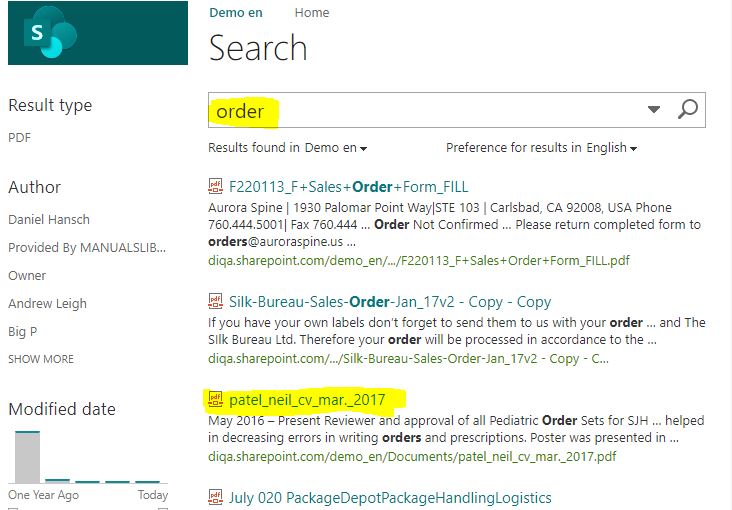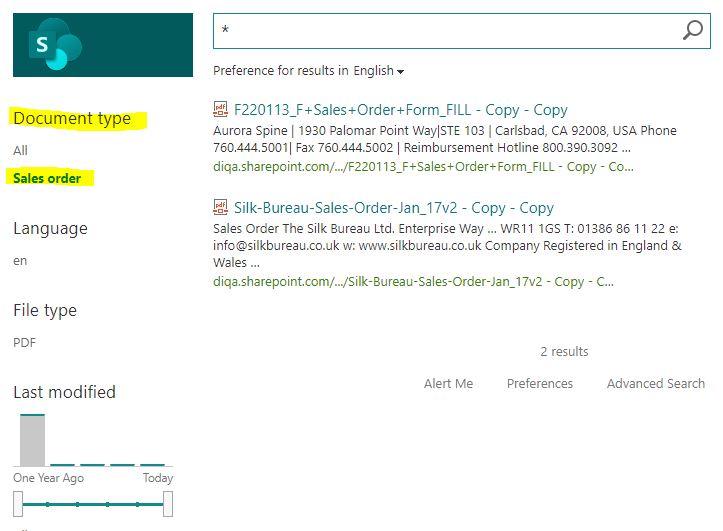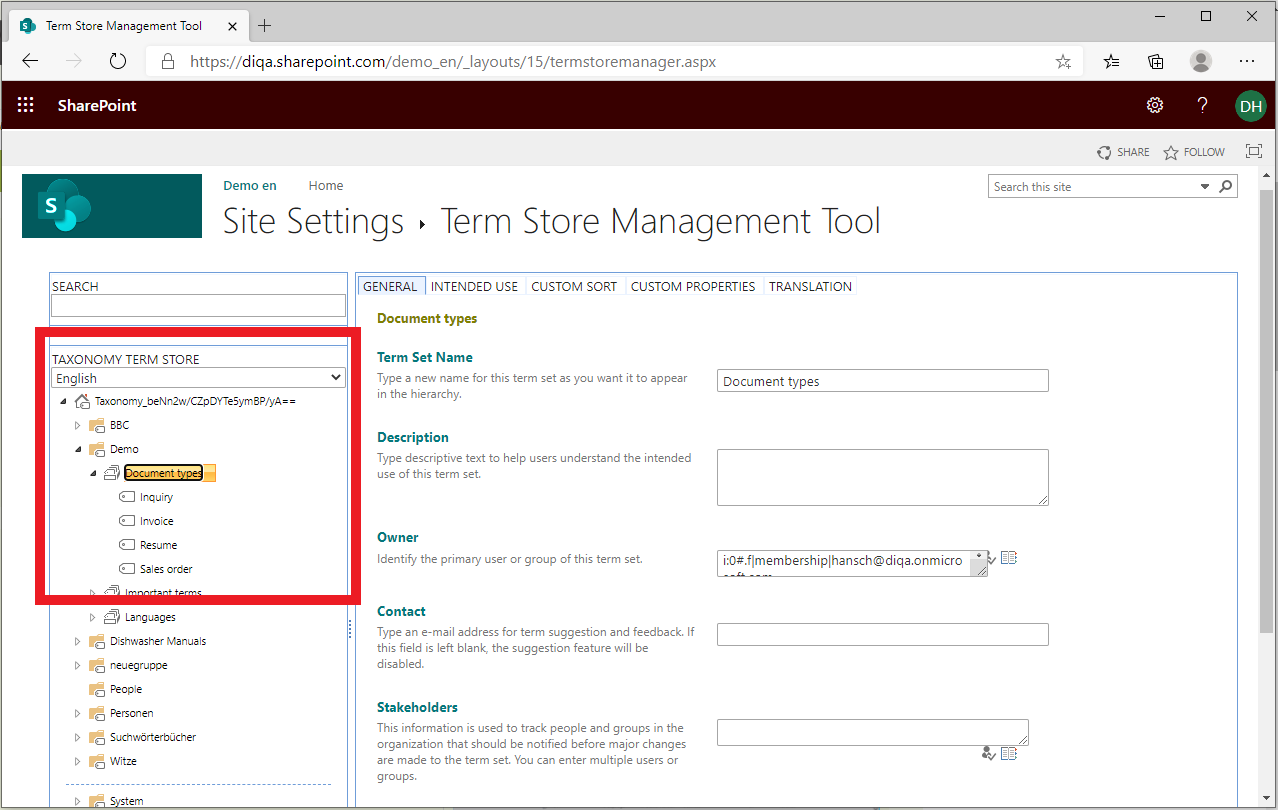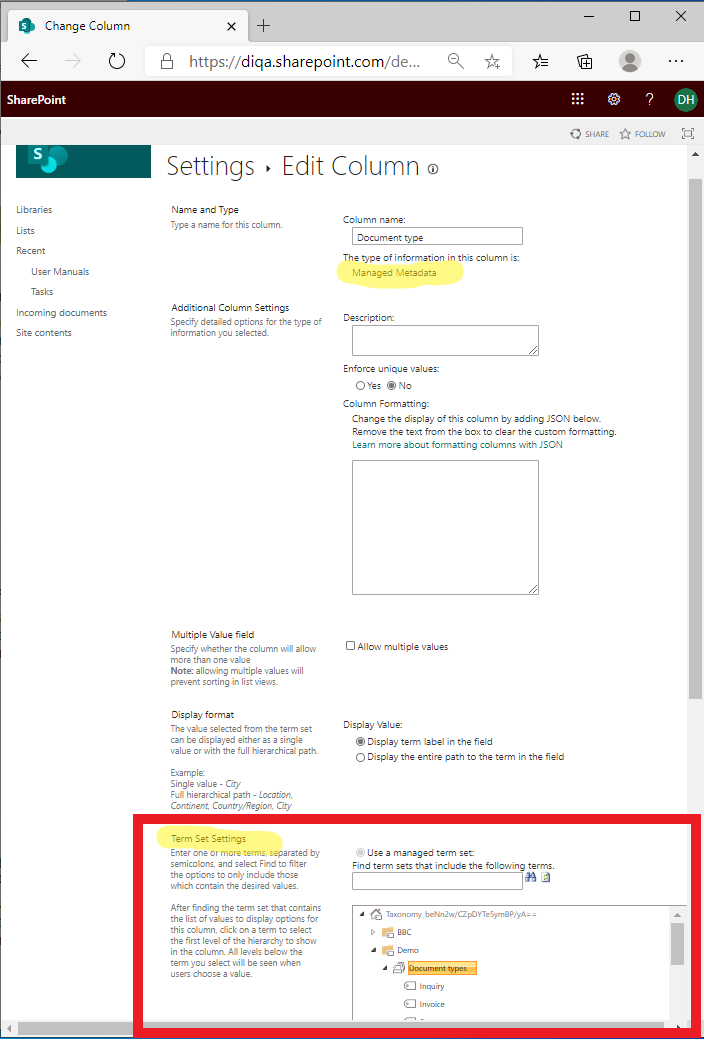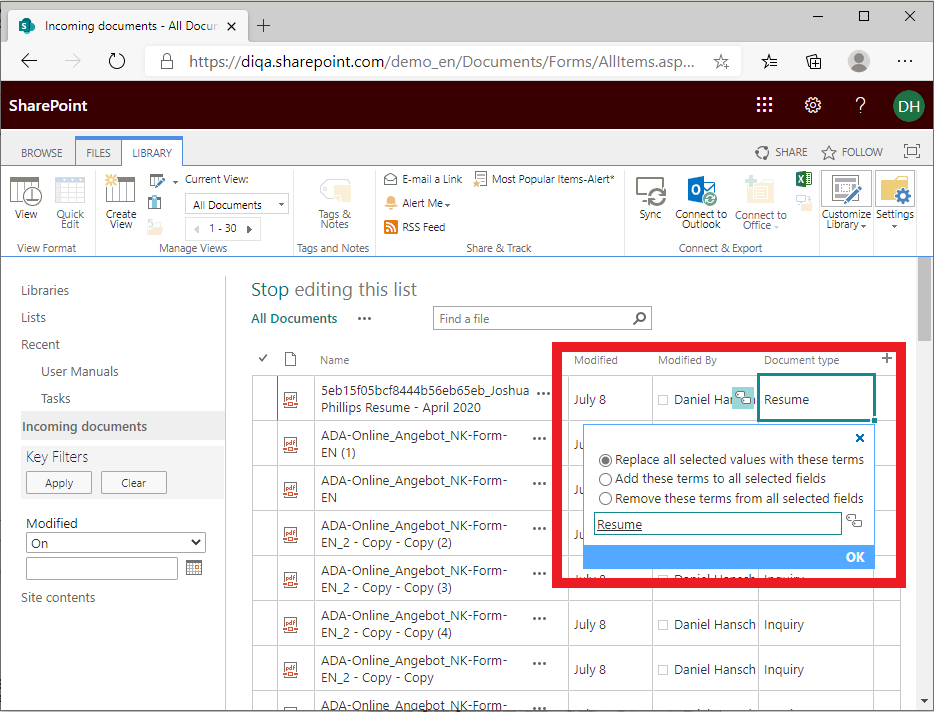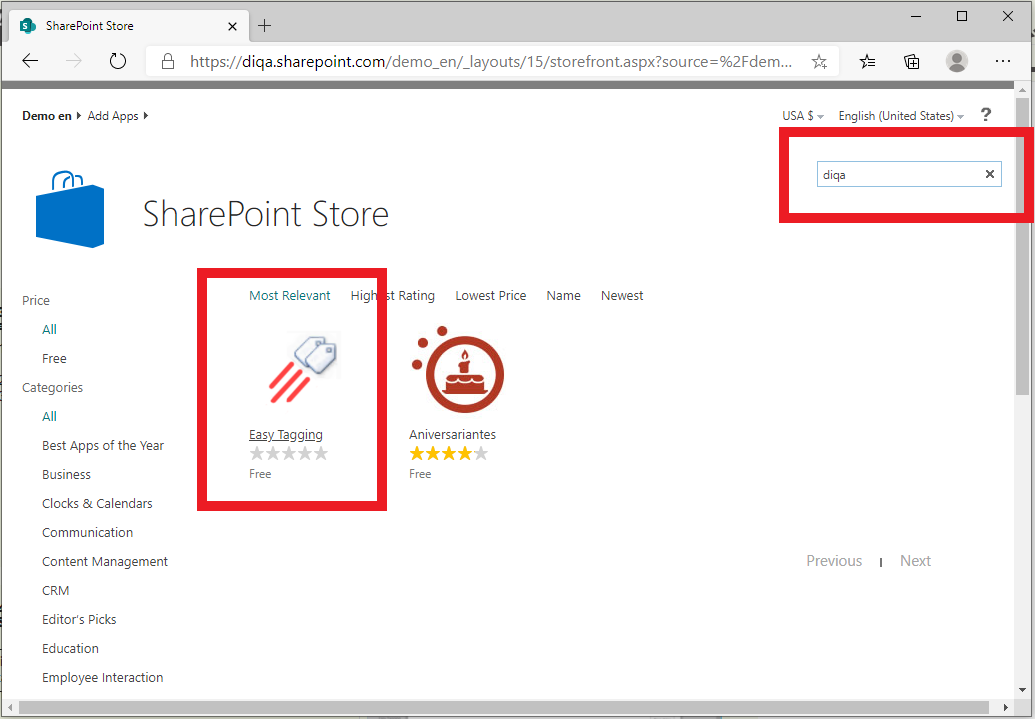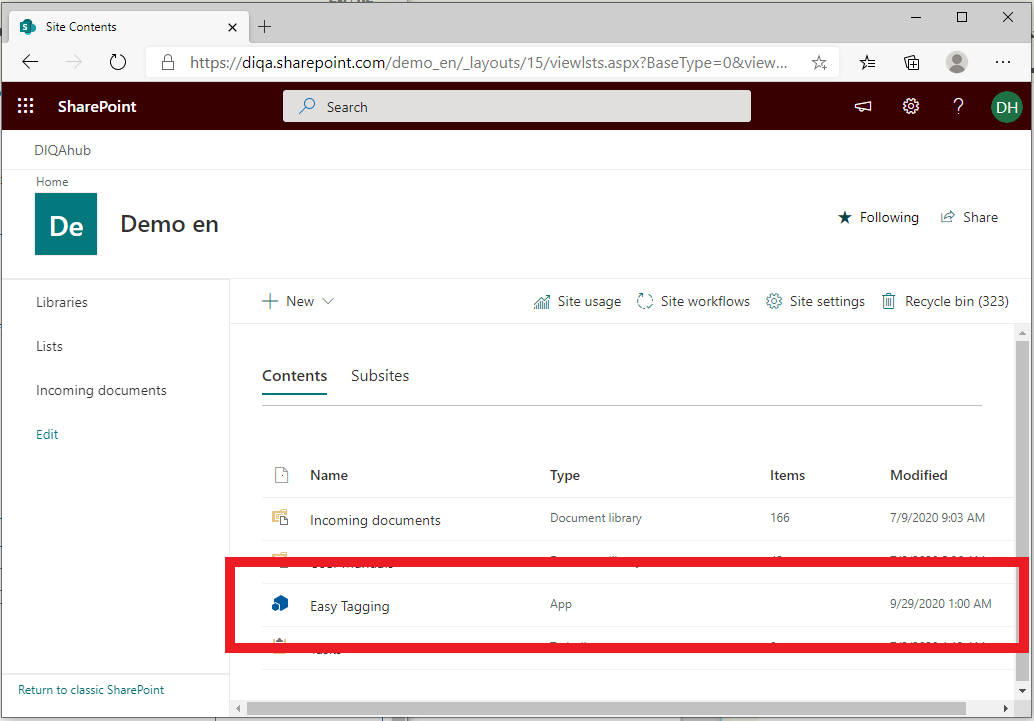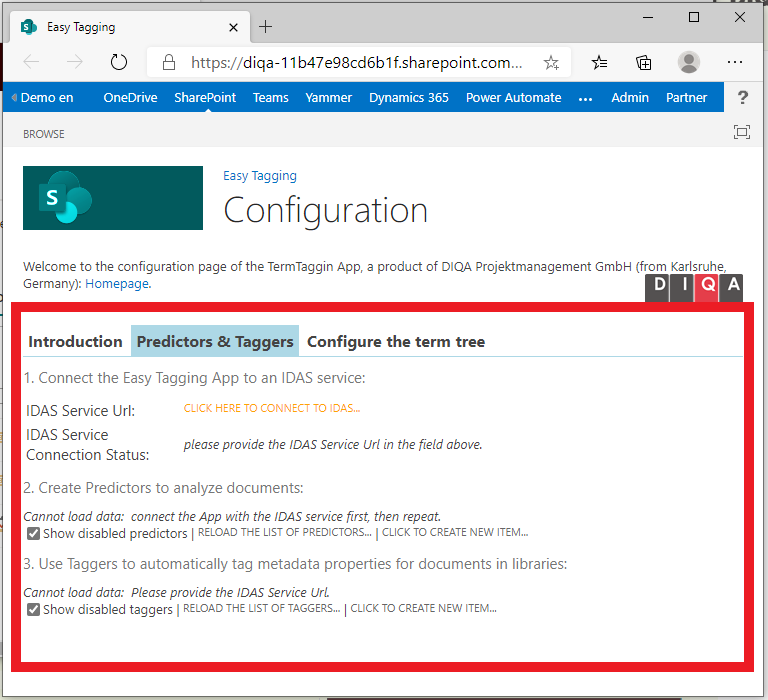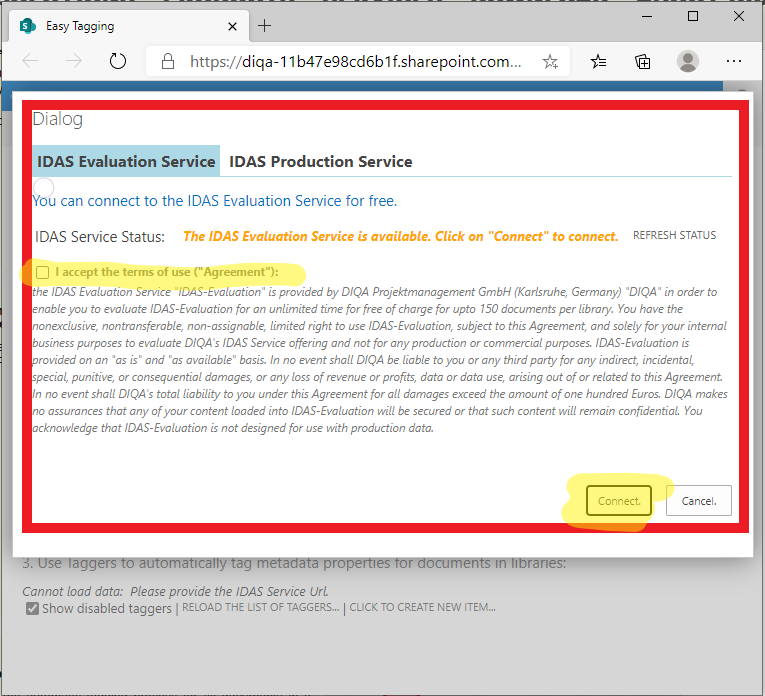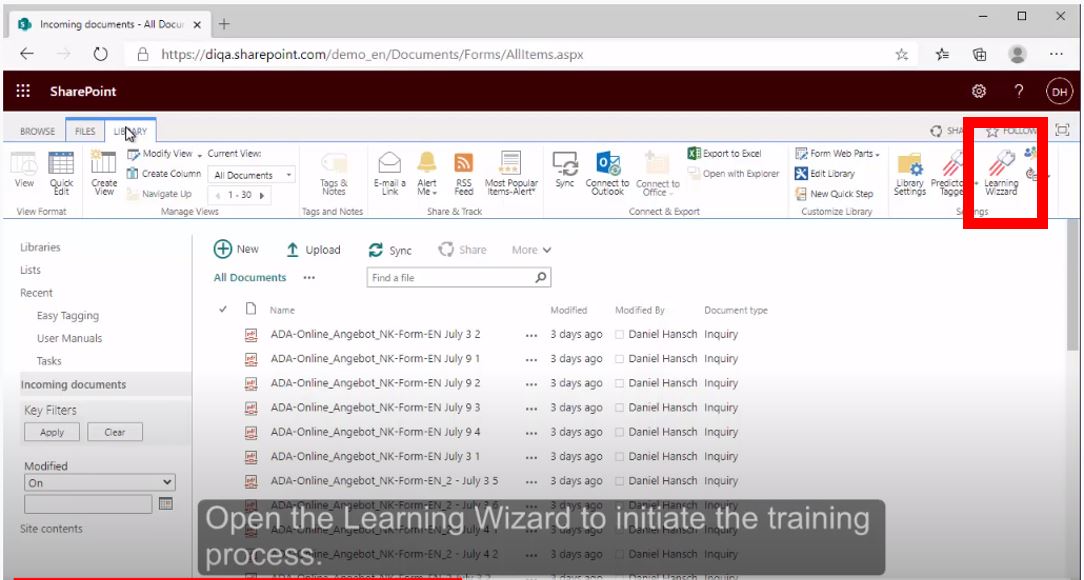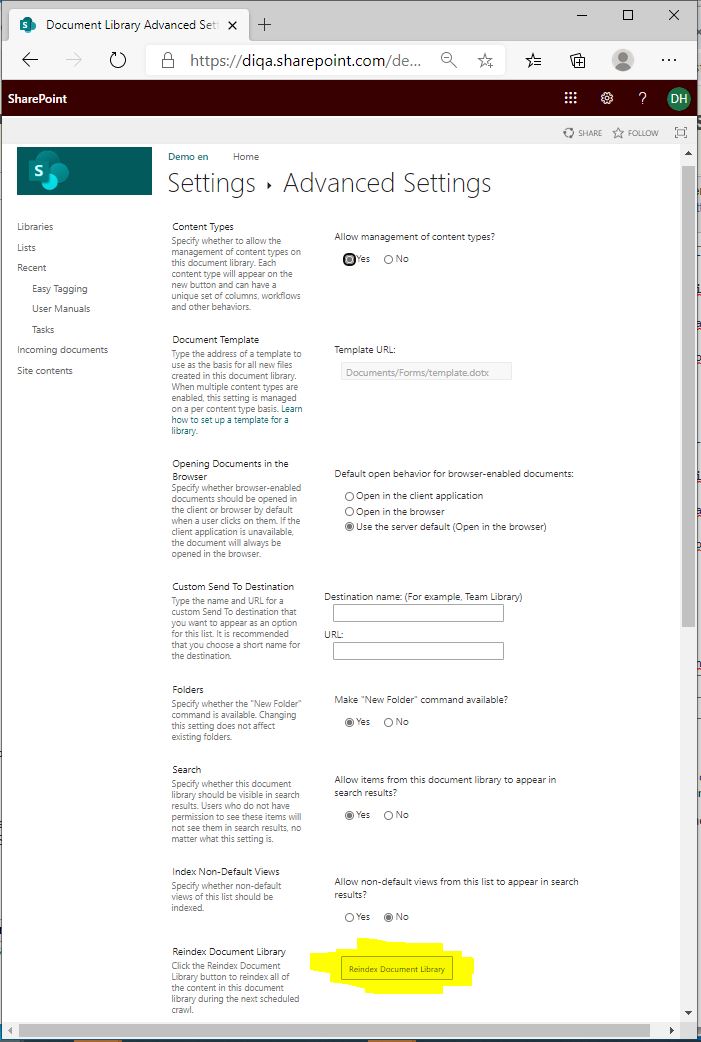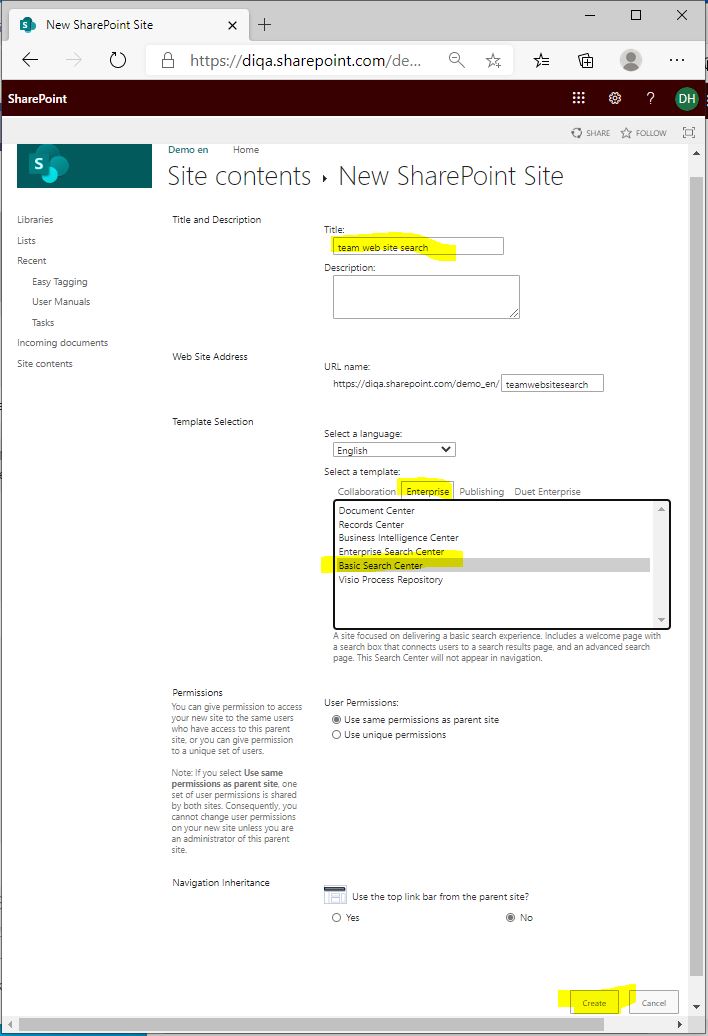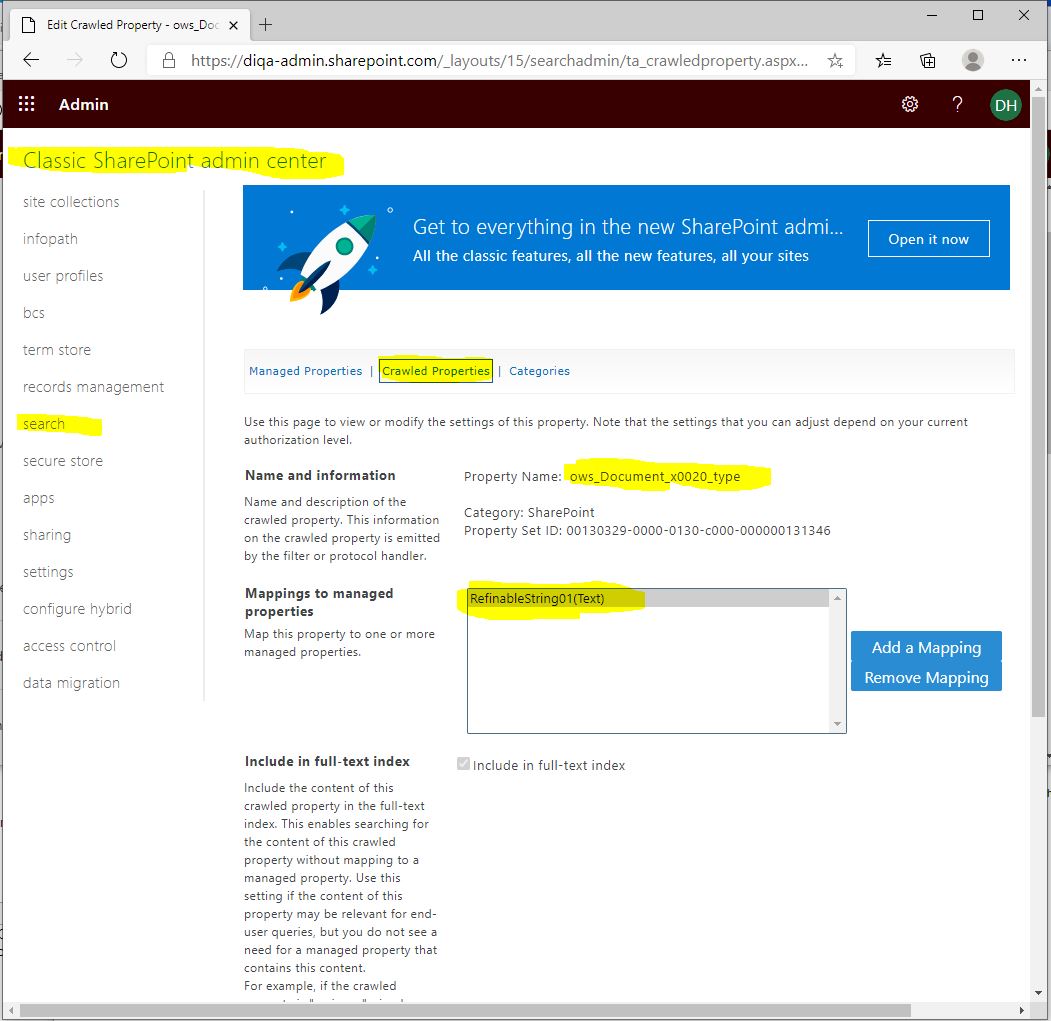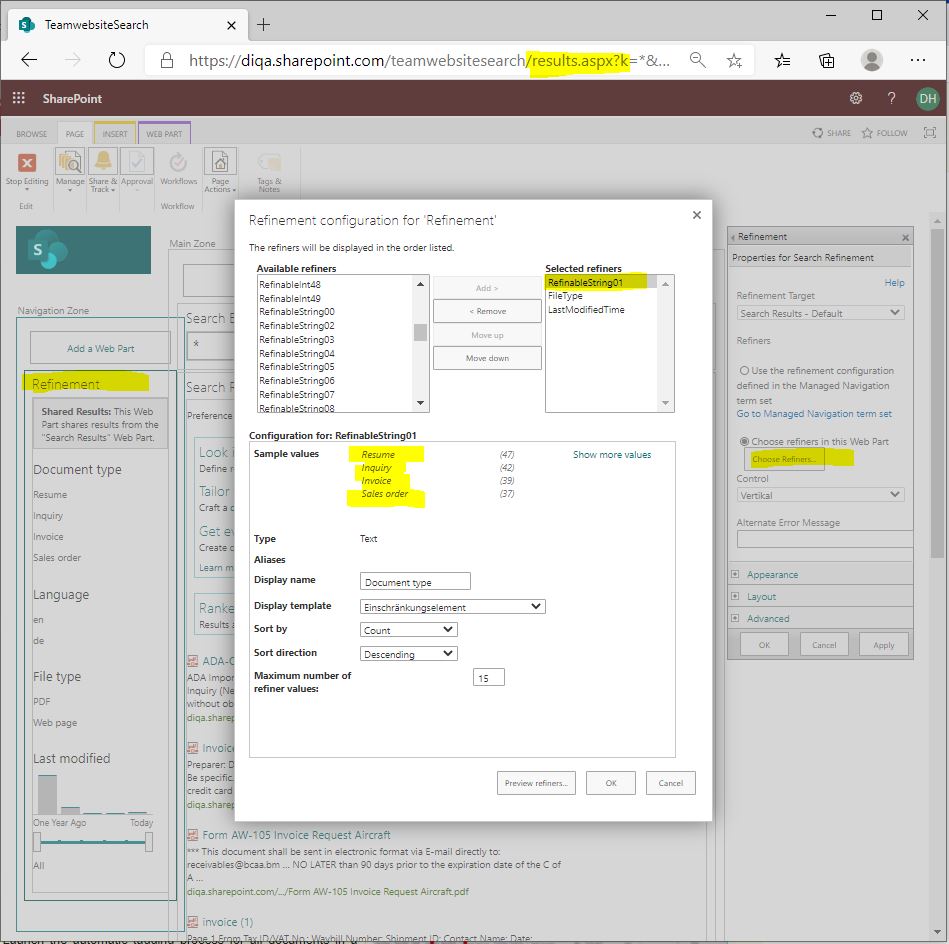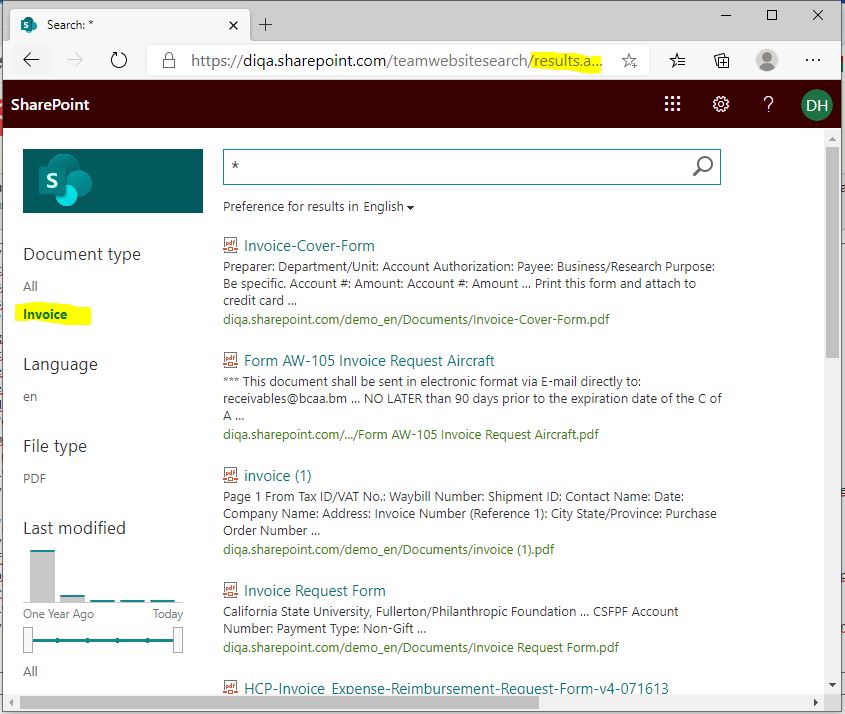Difference between revisions of "Blog/Boost document findability with tags in O365"
| (30 intermediate revisions by the same user not shown) | |||
| Line 1: | Line 1: | ||
{{BlogHeader | {{BlogHeader | ||
| − | |Titel=O365: Boost document findability with | + | |Titel=O365: Boost document findability with autotagging |
| − | |News image= | + | |News image=File:EasyTaggingText.png |
|Publication date=2020/09/01 | |Publication date=2020/09/01 | ||
| − | |Published= | + | |Published=1 |
| − | |Keywords= | + | |Keywords=sharepoint, office 365, o365 |
| − | |SEO-Description= | + | |SEO-Description=Automatic document tagging boosts your document findability? ⇒reade more! |
| − | |Description= | + | |Description=Finding documents in Sharepoint online/Office 365 can be tedious. If you want to restrict your search to certain document types (like: reports, inquiries, CVs, sales orders, invoices) you either end up with too many irrelevant search hits or relevant documents don't show up because they don't include the search term. If you rely on Sharepoint's fulltext search capabilities only, then your users will be frustrated and spend too much time to find the right documents. |
|en_link= | |en_link= | ||
|de_link= | |de_link= | ||
| Line 36: | Line 36: | ||
<!-- --></div> | <!-- --></div> | ||
</div> <!-- row --> | </div> <!-- row --> | ||
| + | |||
| + | <p> | ||
| + | The following steps assume that you have Sharepoint Online/Office 365 and a library that contains at least dozens of documents or scanned documents (pdf or image formats). If you are familiar with certain configuration aspects of Sharepoint then you will need 30 minutes to go them through in your tenant. If you require assistance then we are happy to help!</p> | ||
| + | |||
| + | |||
| + | == Watch the steps in the video: == | ||
| + | <div> | ||
| + | <p> | ||
| + | {{#widget:YouTube | ||
| + | |id=hMaEIa2DMNs | ||
| + | }} | ||
| + | </p> | ||
| + | </div> | ||
<div id="accordionwrapper" width="100%" style=""> | <div id="accordionwrapper" width="100%" style=""> | ||
| − | <div class="spinner" style="display: block | + | <div class="spinner" style="display: block;"> |
<div class="bounce1"></div> | <div class="bounce1"></div> | ||
<div class="bounce2"></div> | <div class="bounce2"></div> | ||
<div class="bounce3"></div> | <div class="bounce3"></div> | ||
</div> | </div> | ||
| − | <div id="accordion" width="100%" style="display: none | + | <div id="accordion" width="100%" style="display: none;"> |
| − | <h2>Step 1: Prepare your library | + | <h2>Step 1: Prepare your library</h2> |
<div> | <div> | ||
<p> | <p> | ||
| Line 54: | Line 67: | ||
# Create a term for each document type that you keep in your document library, e.g. inquiry, invoice, sales order, resume | # Create a term for each document type that you keep in your document library, e.g. inquiry, invoice, sales order, resume | ||
<!-- --></div> | <!-- --></div> | ||
| − | <!-- --><div class="col-md-6 col-md-border funktionen imageExpand" style="text-align: justify; >[[File:Create_termset.png | + | <!-- --><div class="col-md-6 col-md-border funktionen imageExpand" style="text-align: justify; >[[File:Create_termset.png|center|middle]]</div> |
</div> | </div> | ||
<div class="row funktionen-row"> | <div class="row funktionen-row"> | ||
| Line 67: | Line 80: | ||
# Click on "Save" to close the form | # Click on "Save" to close the form | ||
<!-- --></div> | <!-- --></div> | ||
| − | <!-- --><div class="col-md-6 col-md-border funktionen imageExpand" style="text-align: justify; >[[File:Create_column.png | + | <!-- --><div class="col-md-6 col-md-border funktionen imageExpand" style="text-align: justify; >[[File:Create_column.png|center|middle]]</div> |
</div> | </div> | ||
<div class="row funktionen-row"> | <div class="row funktionen-row"> | ||
| Line 75: | Line 88: | ||
# Open the "Quick Edit" view of the library. | # Open the "Quick Edit" view of the library. | ||
# Populate the field "Document types" with meaningful values for a couple of documents per document type. It is not necessary to provide each document with a tag, but the more examples you provide, the better the results will be. You should achieve a coverage of 20% of all documents per document type (and at least 10 examples per document type). | # Populate the field "Document types" with meaningful values for a couple of documents per document type. It is not necessary to provide each document with a tag, but the more examples you provide, the better the results will be. You should achieve a coverage of 20% of all documents per document type (and at least 10 examples per document type). | ||
| + | <big>You have now prepared everything required to teach the "Easy Tagging App" about your way to tag. You can now carry on and install the Easy Tagging App and train the "Learn Tags"-predictor.</big> | ||
<!-- --></div> | <!-- --></div> | ||
| − | <!-- --><div class="col-md-6 col-md-border funktionen imageExpand" style="text-align: justify; >[[File:Tagexample.png | + | <!-- --><div class="col-md-6 col-md-border funktionen imageExpand" style="text-align: justify; >[[File:Tagexample.png|center|middle]]</div> |
</div> | </div> | ||
</p> | </p> | ||
</div> | </div> | ||
| − | <h2>Step 2: Automatically tag all your documents | + | <h2>Step 2: Automatically tag all your documents</h2> |
| − | |||
| − | |||
| − | |||
<div> | <div> | ||
<p> | <p> | ||
| Line 93: | Line 104: | ||
# In the Sharepoint Store: enter "diqa" as search term | # In the Sharepoint Store: enter "diqa" as search term | ||
# Click on the "Easy Tagging" card to initiate the installation. | # Click on the "Easy Tagging" card to initiate the installation. | ||
| + | <br><br> | ||
| + | :Direct link to the Microsoft App Store: | ||
| + | <html><a href="https://appsource.microsoft.com/en-us/product/office/WA200000136?tab=Overview" target="_self" title="Go to Microsoft AppSource"> ▶ Got to Microsoft AppSource</a></html> | ||
| + | |||
<!-- --></div> | <!-- --></div> | ||
| − | <!-- --><div class="col-md-6 col-md-border funktionen imageExpand" style="text-align: justify; >[[File:Appstore.png | + | <!-- --><div class="col-md-6 col-md-border funktionen imageExpand" style="text-align: justify; >[[File:Appstore.png|center|middle]]</div> |
</div> | </div> | ||
<div class="row funktionen-row"> | <div class="row funktionen-row"> | ||
| Line 103: | Line 118: | ||
# The configuration page of the app opens in a new tab. | # The configuration page of the app opens in a new tab. | ||
<!-- --></div> | <!-- --></div> | ||
| − | <!-- --><div class="col-md-6 col-md-border funktionen imageExpand" style="text-align: justify; >[[File:Launch_the_app_modern.png | + | <!-- --><div class="col-md-6 col-md-border funktionen imageExpand" style="text-align: justify; >[[File:Launch_the_app_modern.png|center|middle]]</div> |
</div> | </div> | ||
<div class="row funktionen-row"> | <div class="row funktionen-row"> | ||
| Line 111: | Line 126: | ||
# Click on the link "Click here to connect to IDAS" | # Click on the link "Click here to connect to IDAS" | ||
<!-- --></div> | <!-- --></div> | ||
| − | <!-- --><div class="col-md-6 col-md-border funktionen imageExpand" style="text-align: justify; >[[File:Apptab.png | + | <!-- --><div class="col-md-6 col-md-border funktionen imageExpand" style="text-align: justify; >[[File:Apptab.png|center|middle]]</div> |
</div> | </div> | ||
| Line 122: | Line 137: | ||
# The dialog closes and you can setup a predictor. | # The dialog closes and you can setup a predictor. | ||
<!-- --></div> | <!-- --></div> | ||
| − | <!-- --><div class="col-md-6 col-md-border funktionen imageExpand" style="text-align: justify; >[[File:Connect2.png | + | <!-- --><div class="col-md-6 col-md-border funktionen imageExpand" style="text-align: justify; >[[File:Connect2.png|center|middle]]</div> |
| − | |||
| − | |||
| − | |||
| − | |||
| − | |||
| − | |||
| − | |||
| − | |||
| − | |||
| − | |||
| − | |||
| − | |||
| − | |||
| − | |||
| − | |||
| − | |||
| − | |||
| − | |||
</div> | </div> | ||
<div class="row funktionen-row"> | <div class="row funktionen-row"> | ||
<!-- --><div class="col-md-6 col-md-border funktionen" style="text-align: justify; "> | <!-- --><div class="col-md-6 col-md-border funktionen" style="text-align: justify; "> | ||
| − | === | + | === 5. Launch the "Learning Wizard" in your library === |
| − | # | + | # After you have created a connection to the IDAS Evaluation service you can launch the "Learning Wizard" which will guide you through the process to learn from your examples and to tag your documents. |
| − | # Click on " | + | # Return to your library and open the "Library Settings" ribbon. |
| − | # | + | # Click on the "Learning Wizard" icon which launches the wizard in a dialog. |
| − | # | + | # Go through the three steps: |
| − | # | + | ## Click on "Click to start the wizard" |
| − | # | + | ## Step 1: select the language that is used in most of the documents of the library. If you documents in other languages: just select english. |
| + | ## Step 1: in the field "Learn to predict tags from this managed metadata column": select the "document types" column that you created in the earlier steps | ||
| + | ## Step 2: your library is analysed for sufficient examples. If you don't have enough examples: please add further examples before you continue with the wizard. | ||
| + | ## Step 3: select the column which will receive the document type tags: just keep the selection. | ||
| + | ## Step 3: click on the link "Start Learning and Tagging". | ||
| + | # The learning and tagging processes are running in the background. | ||
| + | # You can inspect the progress in the library ribbon "Predictors + Taggers" | ||
<!-- --></div> | <!-- --></div> | ||
| − | <!-- --><div class="col-md-6 col-md-border funktionen imageExpand" style="text-align: justify; >[[File: | + | <!-- --><div class="col-md-6 col-md-border funktionen imageExpand" style="text-align: justify; >[[File:Start_learning_wizard.JPG|center|middle]]</div> |
</div> | </div> | ||
<div class="row funktionen-row"> | <div class="row funktionen-row"> | ||
<!-- --><div class="col-md-6 col-md-border funktionen" style="text-align: justify; "> | <!-- --><div class="col-md-6 col-md-border funktionen" style="text-align: justify; "> | ||
| − | === | + | === 6. Important: re-index your document library === |
| − | + | # Opent the settings of your library | |
| + | # Click on "re-index document library" | ||
| + | # Click on "Ok" to close the form | ||
| + | <big>Now all your documents in the library have been provided with tags, and the search index is being updated in the background. You can now carry on and setup the search page that uses these tags.</big> | ||
<!-- --></div> | <!-- --></div> | ||
| − | <!-- --><div class="col-md-6 col-md-border funktionen imageExpand" style="text-align: justify; >[[File: | + | <!-- --><div class="col-md-6 col-md-border funktionen imageExpand" style="text-align: justify; >[[File:Library_settings.JPG|center|middle]]</div> |
</div> | </div> | ||
</p> | </p> | ||
| Line 168: | Line 174: | ||
<div class="row funktionen-row"> | <div class="row funktionen-row"> | ||
<!-- --><div class="col-md-6 col-md-border funktionen" style="text-align: justify; "> | <!-- --><div class="col-md-6 col-md-border funktionen" style="text-align: justify; "> | ||
| − | === Create an Enterprise Search Center === | + | === 1. Create an Enterprise Search Center === |
| − | + | # Open the contents of your Sharepoint site and click on "subsites". | |
| + | # Create a new sub site by clicking on the "New" action link. | ||
| + | # A form opens where you specify the new sub site. | ||
| + | # In the template field: select "Enterprise/Basic Search Center". | ||
| + | # Click on "Create" to create the new seach center. | ||
<!-- --></div> | <!-- --></div> | ||
| − | <!-- --><div class="col-md-6 col-md-border funktionen imageExpand" style="text-align: justify; >[[File: | + | <!-- --><div class="col-md-6 col-md-border funktionen imageExpand" style="text-align: justify; >[[File:Create_search_center.JPG|center|middle]]</div> |
</div> | </div> | ||
<div class="row funktionen-row"> | <div class="row funktionen-row"> | ||
<!-- --><div class="col-md-6 col-md-border funktionen" style="text-align: justify; "> | <!-- --><div class="col-md-6 col-md-border funktionen" style="text-align: justify; "> | ||
| − | === | + | === 2. Adjust the search schema: map the crawled property to a refinable managed property === |
| − | + | # Open the Sharepoint admin center for your tenant. | |
| + | # Click on the "Search" section | ||
| + | # In the Search section: click on "Search schema" | ||
| + | # In the "Search schema" settings: activate the tab "Crawled properties" | ||
| + | # Search for all crawled properties that start with the string "ows_" | ||
| + | # Select the crawled property that relates to your "document type"-managed property, e.g. "ows_Document_x0020_type" | ||
| + | # Create a mapping to the managed property "RefinableString01" (or 00, or any other number). | ||
| + | # Save the settings. | ||
<!-- --></div> | <!-- --></div> | ||
| − | <!-- --><div class="col-md-6 col-md-border funktionen imageExpand" style="text-align: justify; >[[File: | + | <!-- --><div class="col-md-6 col-md-border funktionen imageExpand" style="text-align: justify; >[[File:Searchschema.JPG|center|middle]]</div> |
</div> | </div> | ||
<div class="row funktionen-row"> | <div class="row funktionen-row"> | ||
<!-- --><div class="col-md-6 col-md-border funktionen" style="text-align: justify; "> | <!-- --><div class="col-md-6 col-md-border funktionen" style="text-align: justify; "> | ||
| − | === | + | === 3. Add the new refiner to the search page === |
| − | + | # Open the search center | |
| + | # Open the search results page (named "results.aspx") | ||
| + | # Click on "Edit page" | ||
| + | # In the page edit view: open the property settings of the Refinement webpart | ||
| + | # Click on the button "Choose refiners" | ||
| + | # In the "refinement configuration" dialog: add the refinable managed propery | ||
| + | (from the search schema step), like: RefinableString00 (or 01 etc). | ||
| + | # You should see sample values that contain you document types. | ||
| + | # Click on "Ok" to add RefinableString00 to the refiner | ||
| + | # Save the modified properties of the webpart by clicking on "OK" | ||
| + | # Store the modified page. | ||
<!-- --></div> | <!-- --></div> | ||
| − | <!-- --><div class="col-md-6 col-md-border funktionen imageExpand" style="text-align: justify; >[[File: | + | <!-- --><div class="col-md-6 col-md-border funktionen imageExpand" style="text-align: justify; >[[File:Search_refiner.JPG|center|middle]]</div> |
| − | |||
| − | |||
| − | |||
| − | |||
| − | |||
| − | |||
| − | </div> | ||
</div> | </div> | ||
| + | <div class="row funktionen-row"> | ||
| + | <!-- --><div class="col-md-6 col-md-border funktionen" style="text-align: justify; "> | ||
| + | === 4. verify the search results === | ||
| + | # Open the search center | ||
| + | # Enter "*" as search string and submit the query | ||
| + | # Inspect the refiner values: they should include your document types | ||
| + | # Click on a refiner value, like "invoice", in order to restrict your search results to contain only invoices and bills. | ||
| + | <big>If the new refiner does not contain values then you have to wait until the Sharepoint online search engine has completed re-indexing your library. If still no values show up then you have to go back to your library settings and click on "re-index library".</big> | ||
| + | <!-- --></div> | ||
| + | <!-- --><div class="col-md-6 col-md-border funktionen imageExpand" style="text-align: justify; >[[File:Searchresults.JPG|center|middle]]</div> | ||
</div> | </div> | ||
| + | </p></div></div> | ||
| + | ==What's next?== | ||
| + | * Add refiners for the document language like: english, french, german, spanisch | ||
| + | ** The Easy Tagging App has a built-in predictor that detects the language that is used in documents. You can simply use that predictor in a tagger to tag all your documents with the language. Similar to the steps in section 3 you would simply create another refiner that allows users to restrict their search results to certain languages. | ||
| + | * Add refiners for important words: | ||
| + | ** The Easy Tagging App is able to identify important words from documents and store them in the termstore as a new termset. If you let the tagger tag your documents with them, then your users can use them to filter their search results. | ||
| + | ==Questions?== | ||
| + | {{Emailformular | ||
| + | |Text=Hi DIQA! Can you give us assistance? | ||
| + | |Placeholder= | ||
| + | }} | ||
| + | </div></div> | ||
<div class="hideSM col-md-4 col-lg-3 col-xl-2"> | <div class="hideSM col-md-4 col-lg-3 col-xl-2"> | ||
| + | {{Linkbox | ||
| + | |color=#a0b844 | ||
| + | |heading=Watch it here: | ||
| + | |links={{#widget:YouTube | ||
| + | |width=100% | ||
| + | |height=100% | ||
| + | |id=hMaEIa2DMNs}} | ||
| + | }} | ||
{{Linkbox | {{Linkbox | ||
|color=#a0b844 | |color=#a0b844 | ||
|heading=related products | |heading=related products | ||
|links= | |links= | ||
| − | + | * [[Easy_Tagging_for_SharePoint_online|Easy Tagging App]] | |
}} | }} | ||
{{Linkbox | {{Linkbox | ||
| Line 208: | Line 258: | ||
|heading=more articles | |heading=more articles | ||
|links= | |links= | ||
| − | * [[Blog]] | + | * [[Blog|DIQA Blog]] |
}} | }} | ||
</div> | </div> | ||
</div> | </div> | ||
Latest revision as of 15:29, 4 November 2020
O365: Boost document findability with autotagging (September 1, 2020)
Finding documents in Sharepoint online/Office 365 can be tedious. If you want to restrict your search to certain document types (like: reports, inquiries, CVs, sales orders, invoices) you either end up with too many irrelevant search hits or relevant documents don't show up because they don't include the search term. If you rely on Sharepoint's fulltext search capabilities only, then your users will be frustrated and spend too much time to find the right documents.
You can provide your users with a better search experience if you use search refiners. Users can further refine their search result by clicking on the refiner values, e.g. to retrieve "sales orders" or "invoices", only. Before you are able to create meaningful search refiners, you have to arrange for a couple of pre-requisites which include tagging documents with tags. This guide shows you how to automatically tag documents with their type (e.g. invoice, sales order, cv, inquiry) and how to provide search refiners that contain these document types.
Frustrating search experience without meaningful refiners:
Entering the search term "order" returns a lot of irrelevant documents (e.g. a CV) and even misses some sales order documents.
The following steps assume that you have Sharepoint Online/Office 365 and a library that contains at least dozens of documents or scanned documents (pdf or image formats). If you are familiar with certain configuration aspects of Sharepoint then you will need 30 minutes to go them through in your tenant. If you require assistance then we are happy to help!
Watch the steps in the video:
What's next?
- Add refiners for the document language like: english, french, german, spanisch
- The Easy Tagging App has a built-in predictor that detects the language that is used in documents. You can simply use that predictor in a tagger to tag all your documents with the language. Similar to the steps in section 3 you would simply create another refiner that allows users to restrict their search results to certain languages.
- Add refiners for important words:
- The Easy Tagging App is able to identify important words from documents and store them in the termstore as a new termset. If you let the tagger tag your documents with them, then your users can use them to filter their search results.
Questions?
